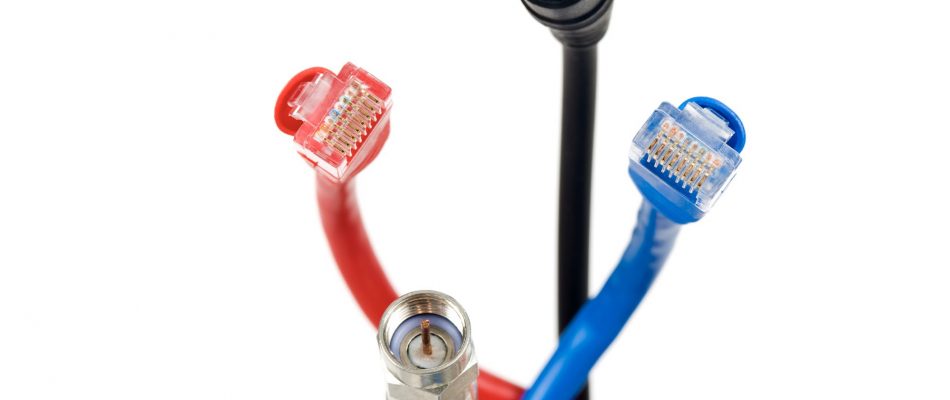The three main types of network cables used in telecommunication systems include coaxial cables, twisted-pair cables, and fiber optic cables.
These cables are different from each other and made for different purposes. They can be used by businesses for effective network cabling. However, they differ in specifications, applications, and features.
Let’s compare these different types of network cables and learn their differences to give you a better idea of coaxial vs. twisted-pair vs. fiber optic cables.
Before we begin, always remember to consult Communication Solutions Inc. in Jacksonville, for the best network cable solutions in Florida.
That being said, let’s begin by looking closely at each type of network cable.
Coaxial Cable
Coaxial cable, also known as coax cable or simply coaxial, is the oldest of the three network cables and is designed to transmit high-frequency signals.
It is made up of a round, central copper conductor at its core, protected by three layers of insulation and shielding. These protective layers include an insulating layer, covered by a mesh of conducting shields, and, lastly, a jacket.
These layers prevent crosstalk and electromagnetic interference (EMI) from external sources like light, motors, electronic devices, and other cables. Moreover, the shield allows the coaxial cable to run longer distances without substantial signal loss.
There are many types of coaxial cables. However, they are all mainly used for digital video signal transmission, cable TV, and satellite TV.
Twisted-Pair Cable
Twisted-pair cables are the most commonly used network cables for Ethernet cabling and are often used for telephone communications as well. The cables are designed for data transmission and are made with twisted pairs of copper wires at their core.
These pairs are twisted to prevent interference from external sources and also crosstalk from neighboring twisted pairs. These cables are categorized broadly into two main categories of unshielded twisted-pair (UTP) and shielded twisted-pair (STP).
STP cables have additional shielding in the form of a braided protective foil around the collective twisted pairs inside the cable. They provide better resistance to interference and crosstalk than UTP cables. There are also foil shielded twisted-pair cables (FTP) that have a foil around individual twisted pairs.
You can learn more about these types of twisted-pair cables used in Ethernet cabling by reading our post on the subject here.
Fiber Optic Cable
Unlike the others, fiber optic cables are Ethernet cables that use light signals, or pulses, to transmit data. They have a glass core that allows light signals to carry data from one device to another. This is what makes them far superior to other Ethernet cables like twisted-pair cables.
They have a transmission capacity that is up to 26,000 times higher than a twisted-pair cable. There are two main types of fiber optic cables; single-mode fiber and multimode fiber. Single-mode fibers have a smaller glass core that only allows a single light signal to travel at any given time.
Whereas multimode fibers have a wider glass core that allows multiple light signals to travel simultaneously. Single-mode fiber cables can travel longer distances of up to a few kilometers than multimode but, the latter has a higher capacity for data transmissions at shorter distances of up to 550 meters.
You can learn all about the basics of fiber optic cables in our detailed post on the subject here.
Coaxial Vs. Twisted Pair Vs. Fiber Optic Cables
Now that you have a better understanding of each of the mentioned network cables and their structural differences, let’s look at their performance, installation, and application differences.
· Performance
Coaxial cable and twisted pair cable are copper-based cables protected by insulating and shielding materials. They both transmit television, telephone, and data through electrical signals, whereas fiber optic cables use light to transmit similar types of signals.
The performance difference is much higher with fiber optics than with the others. They provide wider bandwidth, faster speed, and higher frequencies. Here is a chart to give you an idea of the performance differences of each of these cables.
| Cable Type | Transmission Speed | Bandwidth | Travel Distance |
| Coaxial Cable | – | 750 MHz | Up to 500 meters |
| Twisted-Pair Cable | Up to 10Gbps | Up to 4700 MHz | Up to 100 meters |
| Fiber Optic Cable | Up to 200Gbps | Up to 4700 MHz | Up to 80 kilometers |
The performance difference is greatest between twisted-pair and fiber optics, mainly due to the speed difference between an electrical signal and a light signal.
· Installation & Maintenance
While fiber optic cables are far better than the other two, they are still not as popular or commonly used as twisted-pair or coaxial cables. Fiber optics are faster and more reliable but, because of their glass core, they are also more difficult to install and maintain.
Similarly, the insulating layer of the copper core of a coaxial cable makes it more difficult to install and maintain. This is one of the reasons why twisted-pair is the most popular and common for Ethernet and network needs of businesses around the world.
· Application
Fiber optics are becoming more and more common for businesses and homes due to their performance benefits, however, they are commonly used to connect cities and countries over long distances. They are also great for data centers where large amounts of data transmissions are the norm.
Twisted pair cables are most commonly used in voice and data networking, Ethernet networking, and cable shielding. Whereas coaxial cables have applications in radio transmitters and receivers, network connections, digital audio, and distributing cable TV signals.
Conclusion
In conclusion, there are noticeable differences between coaxial, twisted-pair, and fiber optic cables. However, fiber optic cables are the future and are increasingly trending in global markets due to their high performance that can support developing technologies.
Whether you opt for coaxial cables, twisted-pair cables, or fiber optic cables will depend on the application and performance needs of your business. Although, we highly recommend consulting the expert professionals at Communications Solutions Inc. in Jacksonville for the best cable solutions in Florida.
If you want to learn more about coaxial vs. twisted-pair vs. fiber optic cables, or about the best Ethernet and network cable solutions in Jacksonville, Florida, Contact Us Today.



